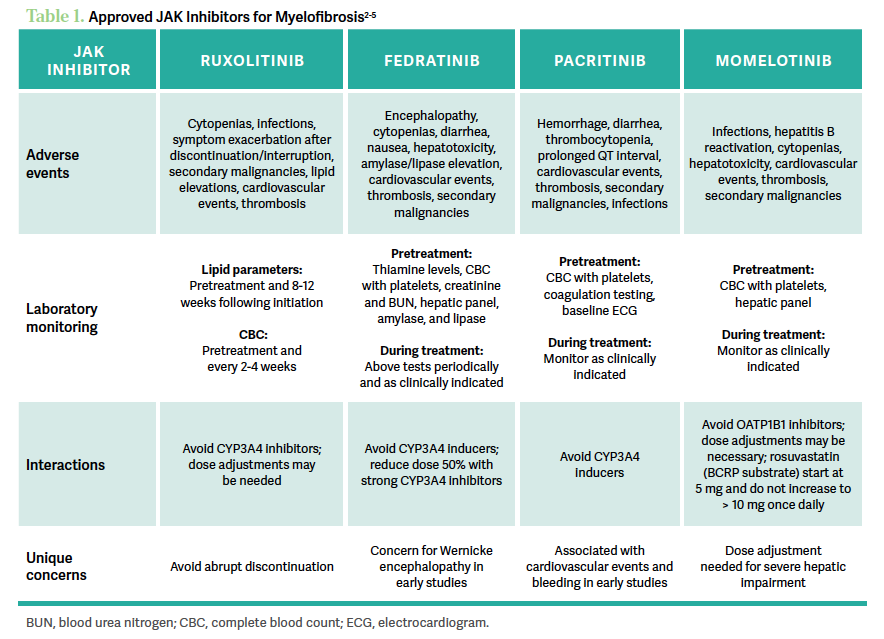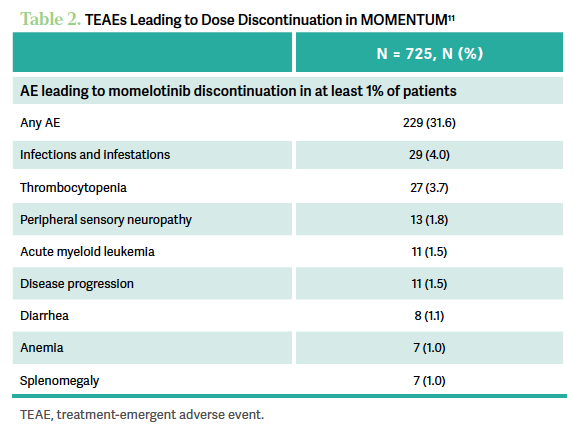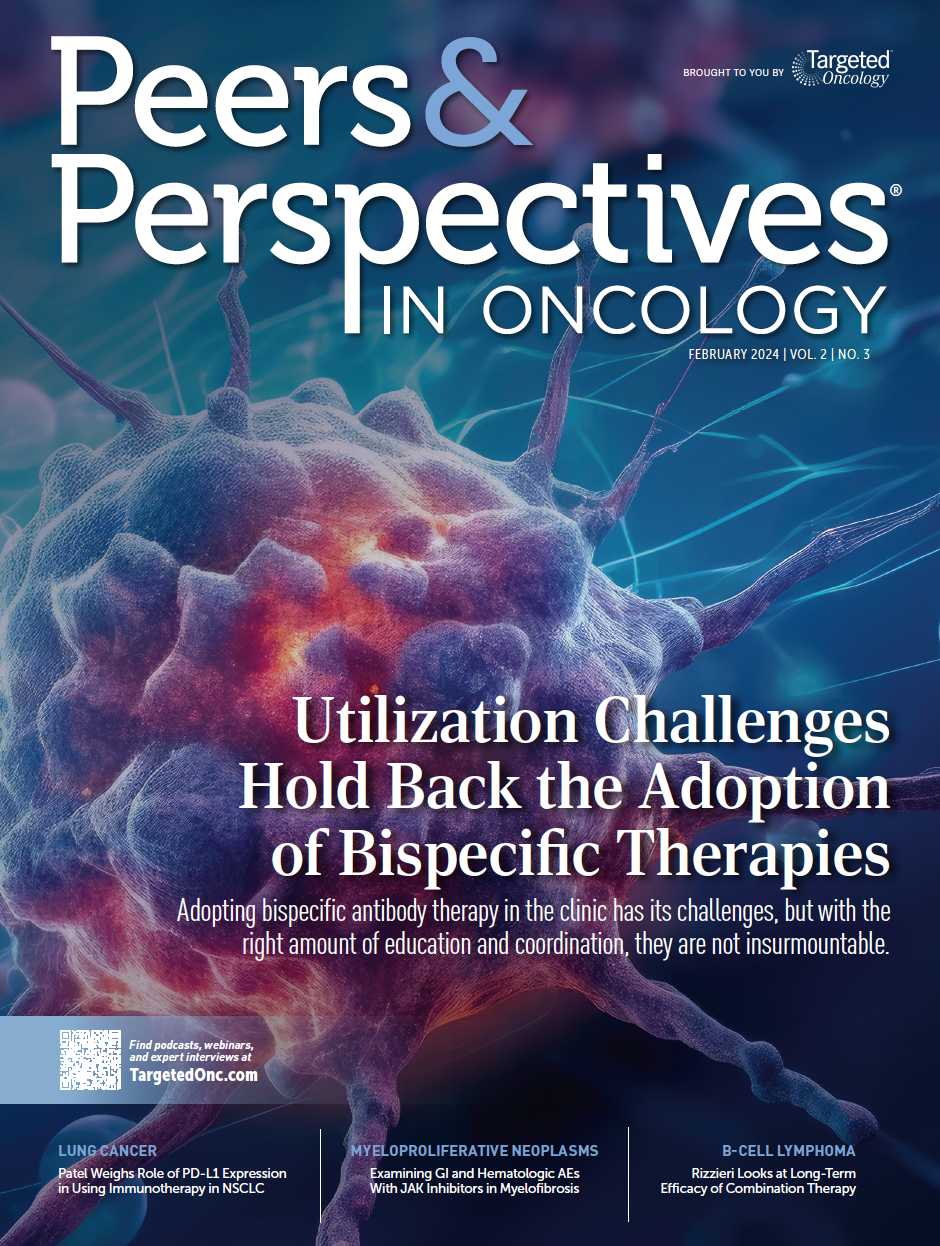Examining GI and Hematologic AEs With JAK Inhibitors in Myelofibrosis
During a Targeted Oncology™ Case-Based Roundtable™ event, Andrew Kuykendall, MD, reviewed adverse events and dosing issues related to the 4 approved JAK inhibitors in patients with myelofibrosis.
Andrew Kuykendall, MD
Assistant Member Department of Malignant Hematology
Moffitt Cancer Center
Tampa, FL

CASE SUMMARY
A 73-year-old man presented to his physician with symptoms of mild fatigue, night sweats, and abdominal pain/fullness lasting 4 months; he also reported unexplained weight loss of 15 lb. Spleen was palpable 8 cm below the left costal margin. He had no known comorbidities.
Laboratory values included red blood cell count of 3.40 × 1012/L, hemoglobin of 10.1 g/dL, and platelet count of 181 × 109/L. Next-generation sequencing showed a JAK2 V617F mutation. Karyotype was 46XY. Bone marrow biopsy showed megakaryocyte proliferation and atypia with evidence of reticulin fibrosis. The patient received a diagnosis of primary myelofibrosis with Dynamic International Prognostic Scoring System high risk, Mutation-Enhanced International Prognostic Score System (MIPSS70) intermediate risk, and MIPSS70+ version 2.0 high risk. The patient was not interested in transplant; a decision was made to initiate ruxolitinib (Jakafi).
What do the National Comprehensive Cancer Network (NCCN) guidelines recommend regarding use of Janus kinase (JAK) inhibitors for patients with higher-risk myelofibrosis?
KUYKENDALL: When we look at the NCCN guidelines, we can see that when we think about myelofibrosis, the guidelines are set up to look at this based upon their risk status. If you think about higher-risk myelofibrosis, in patients who are not a transplant candidate, we recommend either clinical trial, ruxolitinib, or fedratinib [Inrebic].1 There is category 2B evidence for using pacritinib [Vonjo] in this group of patients because pacritinib has been studied in patients who have higher platelet counts. Its impact is not just limited to patients with [a platelet count of] less than 50,000/μL. If patients don’t have a good response, or they lose response, we can consider clinical trials or an alternative JAK inhibitor at that time.
What factors differentiate the approved JAK inhibitors in patients with myelofibrosis?
When we think about JAK inhibitors for myelofibrosis, we’ve got these 4 and…they have different targets, adverse effects [AE], lab monitoring that’s required, drug interactions, and unique concerns [Table 12-5]. Ruxolitinib is the first on the market, with a recent approval over the last 4 years of these other 3 agents. All are recommended for higher-risk myelofibrosis patients, all hit JAK2, although there are some other targets that may be relevant in terms of other benefit profile as well as toxicity profile. I’ll highlight FLT3 inhibition for pacritinib and fedratinib that seems to go along with an increased risk of GI [gastrointestinal] AEs, and ACVR1 inhibition for momelotinib [Ojjaara]. But more recently, pacritinib has been shown to be an ACVR1 inhibitor, which may have a role in anemia benefit. The relevance of some of these other targets is not yet clear. IRAK1 may have some role as far as different symptom improvement and BRD4 may be important as well, but it’s unclear and hasn’t really been fully shown to this extent.

What hematologic AEs were observed with ruxolitinib in the COMFORT-I (NCT00952289) and COMFORT-II (NCT00934544) trials?
[In terms of] hematologic grade 3 or 4 AEs, probably the most common adverse event with ruxolitinib is going to be cytopenia. We looked very closely at COMFORT-I as well as COMFORT-II… as far as grade 3/4 events with ruxolitinib compared with placebo, and I would argue what we see on placebo is just the natural history of the disease. You can see from the natural history of the disease, 20% of patients over this 24-week period are likely to experience grade 3/4 anemia, but just 1% are going to experience grade 3/4 thrombocytopenia, especially in this patient population, where they enrolled patients with platelet counts of over 100,000/μL.6 That being said, ruxolitinib is much more likely to induce grade 3/4 anemia, thrombocytopenia, and neutropenia, suggesting this is an on-target impact of ruxolitinib. Similar findings were seen in the COMFORT-II trial. Some of the best available therapies [BATs] that were used seemed to exacerbate that anemia, but not to the extent that ruxolitinib did, and some of these best available therapies cause thrombocytopenia.7 We don’t see a big difference there between ruxolitinib and BAT.
What is the role of anemia in impacting responses to JAK inhibitor therapy?
We always have to tease out what is disease-related anemia and what is treatment-related anemia, and is one the same as the other? Are they the same in terms of their prognostic influence, or are they different? It’s nice to see when you look at patients who had anemia who were treated with ruxolitinib, they were just as likely to get symptom responses and get spleen volume responses.6 We don’t think the development of anemia or preexisting anemia impacts the response that you get to JAK inhibition.
However, it makes things more challenging if you’re having to deal with an increased need for transfusions or symptoms that come with anemia. Nearly half the ruxolitinib-treated patients had baseline anemia and were still able to get these more durable benefits.6 Dose modifications…happen a lot more in clinical practice than on clinical trials, but they can be done and are frequently done to try to mitigate some of this anemia that develops.
What toxicities stood out with pacritinib in the PERSIST-2 trial (NCT02055781)?
Pacritinib does inhibit FLT3, so with that comes an increased risk of GI AEs. We see high rates [including a nearly] 50% rate of diarrhea compared with [15%] with BAT.8 We’re also seeing one-third of patients dealing with some degree of nausea and vomiting. It’s less likely, but certainly there are high rates of diarrhea and nausea, more so than we’re seeing with BAT therapy, although rarely grade 3 or higher.
Q: What treatment-emergent AEs were seen in the SIMPLIFY-1 (NCT01969838) trial, which compared momelotinib with ruxolitinib?
When we look at treatment-emergent AEs, we again saw diarrhea, but to a lesser extent. Only 17% of momelotinib-treated patients got diarrhea; this actually compares favorably to what we see with ruxolitinib [19.9%].9 This is a double-blind study, so patients didn’t know what they were on. These rates of diarrhea are certainly lower than we saw with pacritinib and fedratinib, rates that were closer to 30% or 40%, and [above] 60% for fedratinib. There were also low rates of nausea, [although] nausea was seen more commonly in the momelotinib-treated patients compared with ruxolitinib, where nausea was rarely reported.
Q: What AEs were seen in SIMPLIFY-2 (NCT02101268) for momelotinib in patients who received prior ruxolitinib?
We saw a slight increase in diarrhea here; 31% grade 1 or grade 2 compared with 14% with BAT, so this is a bit different than what we saw on SIMPLIFY-1 where there were lower rates of diarrhea.10 There was nausea in 17% with momelotinib compared with 8% with BAT….
Q: How did the MOMENTUM study (NCT04173494) compare with the other studies of momelotinib in terms of AEs?
Looking at AEs again, we see very similar to what we saw in terms of the SIMPLIFY-1 and SIMPLIFY-2 studies. This is a relatively well-tolerated drug with low rates of opportunistic infections, of [malignancies], nonmelanoma skin cancers, [which were discussed in detail] in a Blood Advances article.11
When you look at treatment-emergent AEs that led to dose interruption or reduction, any AE leading to dose interruption or reduction was seen in 36%.11 Overall that’s a relatively low [rate] in JAK inhibitor trials. We often see dose interruption or reduction occurring more frequently than that. Often, this was due to thrombocytopenia [in 10.5% of patients]. It’s worth noting MOMENTUM enrolled patients with platelets down to 25,000/μL. [There were] some patients with thrombocytopenia who started with platelets of 25000/μL or 30,000/μL. All other reasons were in less than 10% of patients, as far as reasons why someone might reduce the dose or change it.
We’re seeing very rare reasons for discontinuation or interruption in terms of GI AEs [2.1% for nausea, 1.9% for diarrhea]. That’s always reassuring, given what we’ve seen previously with the fedratinib and pacritinib. As far as AEs leading to discontinuation, there wasn’t a common reason to do it, but [the most common] was infections [in 4.0%], and that’s a concern with JAK inhibitors, that they could have some immunosuppression [Table 211]. We also rarely see [discontinuation] related to thrombocytopenia [3.7%]. I would argue that perhaps we’re looking at disease progression in terms of worsening thrombocytopenia.

REFERENCES
1.NCCN. Clinical Practice Guidelines in Oncology. Myeloproliferative neoplasms, version 1.2024. Accessed January 11, 2024. http://tinyurl.com/yw9ka77m
2. Jakafi. Prescribing information. Incyte Corporation; 2023. Accessed January 11, 2024. https://tinyurl.com/ua3rzhwr
3. Inrebic. Prescribing information. Bristol-Myers Squibb; 2023. Accessed January 11, 2024. https://tinyurl.com/ms6emc6k
4. Vonjo. Prescribing information. CTI BioPharma Corp; 2022. Accessed January 11, 2024. https://tinyurl.com/5bpdwhku
5. Ojjaara. Prescribing information. GlaxoSmithKline; 2023. Accessed January 11, 2024. https://tinyurl.com/4wc5dmet
6. Verstovsek S, Mesa RA, Gotlib J, et al. A double-blind, placebo-controlled trial of ruxolitinib for myelofibrosis. N Engl J Med. 2012;366(9):799-807. doi:10.1056/NEJMoa1110557
7. Harrison C, Kiladjian JJ, Al-Ali HK, et al. JAK inhibition with ruxolitinib versus best available therapy for myelofibrosis. N Engl J Med. 2012;366(9):787-798. doi:10.1056/NEJMoa1110556
8. Mascarenhas J, Hoffman R, Talpaz M, et al. Pacritinib vs best available therapy, including ruxolitinib, in patients with myelofibrosis: a randomized clinical trial. JAMA Oncol. 2018;4(5):652-659. doi:10.1001/jamaoncol.2017.5818
9. Mesa RA, Kiladjian JJ, Catalano JV, et al. SIMPLIFY-1: a phase III randomized trial of momelotinib versus ruxolitinib in Janus kinase inhibitor-naïve patients with myelofibrosis. J Clin Oncol. 2017;35(34):3844-3850. doi:10.1200/JCO.2017.73.4418
10. Harrison CN, Vannucchi AM, Platzbecker U, et al. Momelotinib versus best available therapy in patients with myelofibrosis previously treated with ruxolitinib (SIMPLIFY 2): a randomised, open-label, phase 3 trial. Lancet Haematol. 2018;5(2):e73-e81. doi:10.1016/S2352-3026(17)30237-5
11. Verstovsek S, Mesa R, Gupta V, et al. Momelotinib long-term safety and survival in myelofibrosis: integrated analysis of phase 3 randomized controlled trials. Blood Adv. 2023;7(14):3582-3591. doi:10.1182/bloodadvances.2022009311

Leon-Ferre Explores Targeting of PIK3CA Alterations in ER+ Breast Cancer
July 24th 2024During a live Community Case Forum event in partnership with the Minnesota Society of Clinical Oncology, Roberto A. Leon-Ferre, MD, discussed drugs targeting PIK3CA alterations in patients with ER+ metastatic breast cancer.
Read More
Roundtable Roundup: Treatment for Metastatic pMMR Endometrial Cancer
July 23rd 2024In separate, live virtual events, Michael J. Birrer, MD, PhD, and Jubilee Brown, MD, surveyed participants on the treatment of a postmenopausal woman with stage IVA endometrial cancer after first-line chemotherapy.
Read More
George Explores Impact of Risk Status With Cabozantinib/Nivolumab in Advanced RCC
July 19th 2024During a Case-Based Roundtable® event, Daniel George, MD, discussed the results of the CheckMate 9ER trial across favorable, intermediate, and poor risk groups in patients with advanced renal cell carcinoma.
Read More
Depth of Response With Quadruplet Regimens Considered in Newly Diagnosed Multiple Myeloma
July 18th 2024During a Case-Based Roundtable® event, Timothy Schmidt, MD, and participants discussed treatment selection for a 54-year-old patient with transplant eligible R-ISS stage 2/R2-ISS stage 3 IgG-κ myeloma.
Read More
Rossetti Reviews Myelofibrosis Risk Stratification and Outcome Data for Pacritinib
July 17th 2024During a Case-Based Roundtable® event, James M. Rossetti, DO, discussed the role of risk scoring and stratification tools and treatment for a patient with declining hemoglobin and platelet counts due to primary myelofibrosis.
Read More
Phase 3 VERIFY Trial Investigates Rusfertide’s Potential in Polycythemia Vera
July 16th 2024In an interview, Aniket Bankar, MD, discussed the background, design, and goals of the phase 3 VERIFY trial of the hepcidin mimetic rusfertide for the treatment of patients with polycythemia vera.
Read More